In the weeks leading up to the publishing of our May online magazine, I wrote a two-part tactical theory piece on compactness and the influence it has on each phase of the game which was published on the Total Football Analysis website. The theoretical part of the piece points out the main approaches teams adopt when trying to defend compactly, what compact organisation brings to the table when a team is in possession, and why this concept is of great importance even in transition phases of the game.
This tactical analysis will focus on the practical aspect of coaching compactness – using three drills that will help you train your team(s) to become more compact, both offensively and defensively. Two of the drills have coaching points primarily oriented towards the defensive phase however, it is worth noting, defensive compactness is a critical aspect of a compact offence also. As I pointed out in the tactical pieces published online, compactness is a security for one team’s option, and access possibilities since it requires strong connections between teammates that will provide them with support no matter the zone of the pitch or phase of the game.
Defensive compactness is all about the well-organised structure team can create communication between the players from each line and general communication throughout the team, commonly seen from the likes of Red Bull Leipzig, Atletico Madrid and plenty more. Also, it is based upon foundations of constant motions and correction players provide to their teammates in different situations around the field. That’s why these defensive drills have all of these factors included and why the emphasis is on them.
The third session is the one planned for the main part of the practice and it includes all the principles of compactness in every stage of the game. Offensive compactness is often seen as positional play and in order to be performed well, often used by Pep Guardiola’s Manchester City. players need to be aware of their positions and must keep the bonds between their teammates as strong as possible all the time.
So, how do we train it?
Basic movement and correction awareness drill
Okay, the first drill we are going to talk about is probably the simplest one in the book but an important to be practised in order to make your players more familiar with maintaining the links between the team while defending. The setup for this drill can vary regarding the preferable formation coaches use and the ideas on which they base their tactics. In order to explain the drill more easily and to highlight the main coaching points, I place the training team into their defensive shape, a 4-4-2 defensive block, which is one of the most used in modern football.
The layout for this drill requires 25 cones (if you want to train your team in a 4-4-2 manner), set up like in the picture below. Distances between cones range from five to eight meters between some, and ten between the others. The number of players included in a single drill is ten and can be changed to eleven if you want to include the goalkeeper in the teams’ movement in order to help him track the play better.

In the image, we can see the initial setup of the drill. Red circles represent the players in the drill, whilst all the rhombuses (oranges, yellows, blues and yellow-blues) represent cones laid on the ground. At the top of the set up there are three coaches – one centrally (C) and one on each side of the pitch (L/R) who are also included in the action. Their inclusion can be replaced with defensive players who will pass the ball replicating the opposition. It is recommended for you to do it that way in order to train more segments at the same time.
Reds are initially positioned in the central position, one player at each orange cone, positioned in relation to their positions in the game, and the ball is in the feet of central defenders/coach that sits centrally at the start of the drill. The colours of cones are different because of their usage – the blue cones are used when the ball is moved to the left-hand defensive side (right-hand flank of the offence) and the yellows are used for the motions in the opposite direction, while the two-coloured ones are used in both scenarios.
The drill is unopposed and doesn’t require any kind of contact, only movement. It starts out by players/coaches at the top passing the ball between each other, and with the defenders moving in order to orient their block to the ball while keeping good connections between each other.
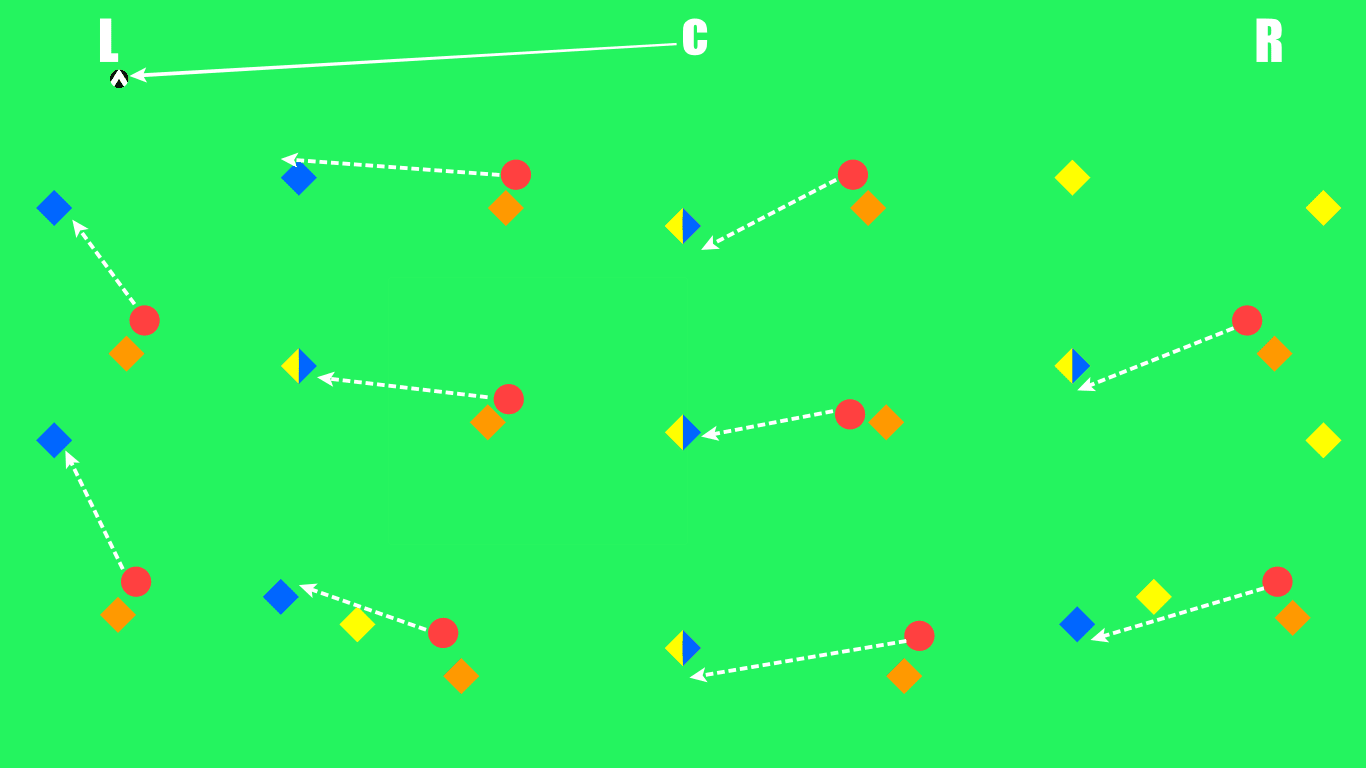
If the ball is passed to the left-hand side of the defence, the players move towards the ball replicating the movements sketched in the diagram above. The idea is for them to move together and to provide each other with correction and defensive security in every situation when defending in the block. It is recommended that coaches encourage communication between the players and explain to them why they move in these patterns.
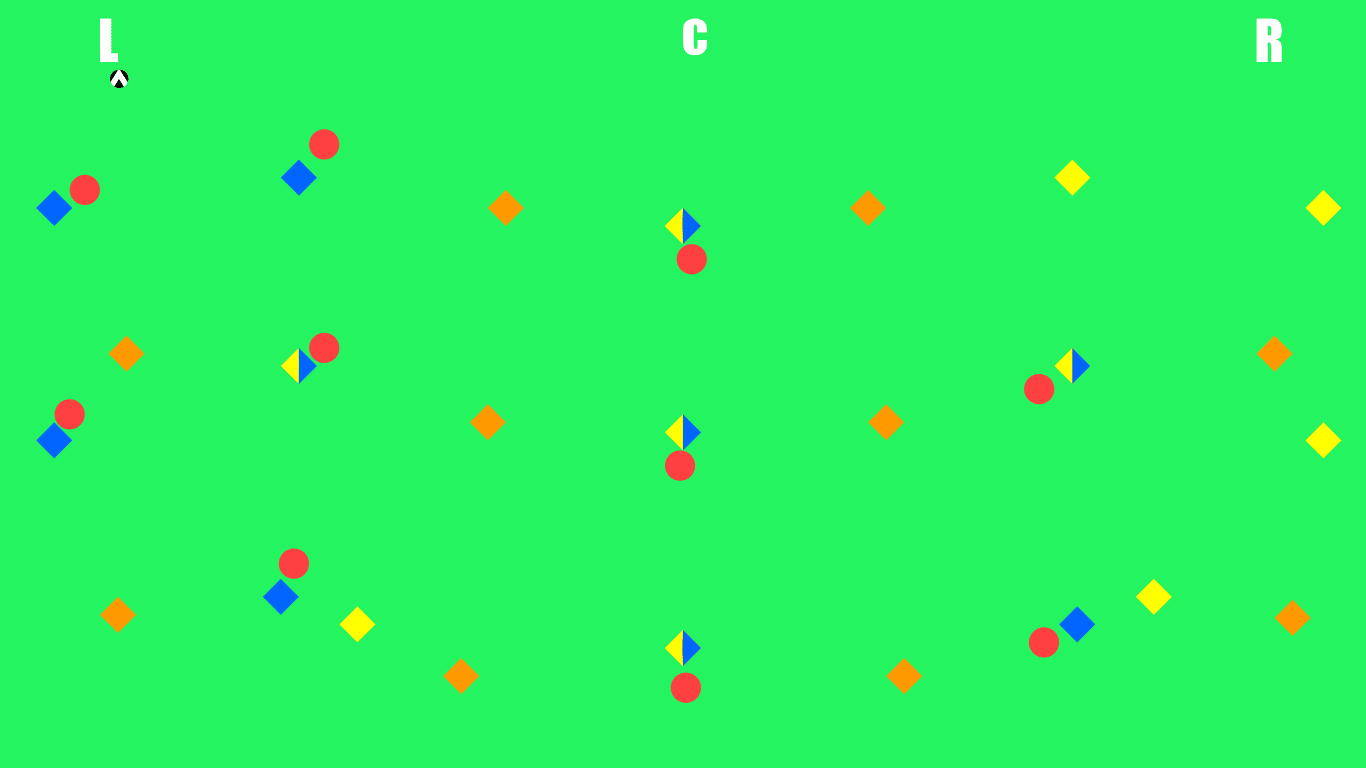
As illustrated, this would ‘roughly’ be the setup for players when the ball is on the flank, and this setup may vary for coaches that have different approaches when it comes to the defensive phase. This drill is used because it can help players get more comfortable in defence and get them used to moving into the right lanes by performing these motions regularly on the training ground. The setup would be the same when the ball is on the right-hand side, but with players moving to the yellow cones i.e. the right-winger who came inside to the yellow-blue cone will now go to the furthest yellow one on the right flank, while the opposite winger will inward himself.
By repeating these motions, the connections between teammates strengthen and they learn to do them automatically. Of course, it is down to the coaches to explain to the players that none of the movements should be performed randomly, and that every single one has its purpose. The idea of this session is to get the players to instinctively move into the correct lanes at speed.
Simeone’s 4+2v4 zone-game
The second drill I’m going to present you is one used by Atletico Madrid’s coach Diego Simeone. This session helps his team improve their line-compactness mostly working on good organisation across the horizontal axis. Additionally, it also forces defenders to think more broadly and also focus on depth when covering for each other and providing support and correction. Also, it helps players to understand their position on the pitch both offensively and defensively, with the addition of deep in-between positioning from an offensive perspective in this practice.
The game takes place in a 12-16×10-12m rectangle that is divided into the eight 3-4×5-6m boxes like in the picture below. Teams (Blues and Reds) are separated by the half-way line and there can not be contact between them. Essentially, the game is a 6v6 where the two attacking players from each team are only active when their team is in possession. Four players from each team are positioned in the eight zones and each player is entitled to one zone and is ‘locked’ into it. The remaining two attacking players are locked in the opposition half, with both of them free to move inside the two areas.
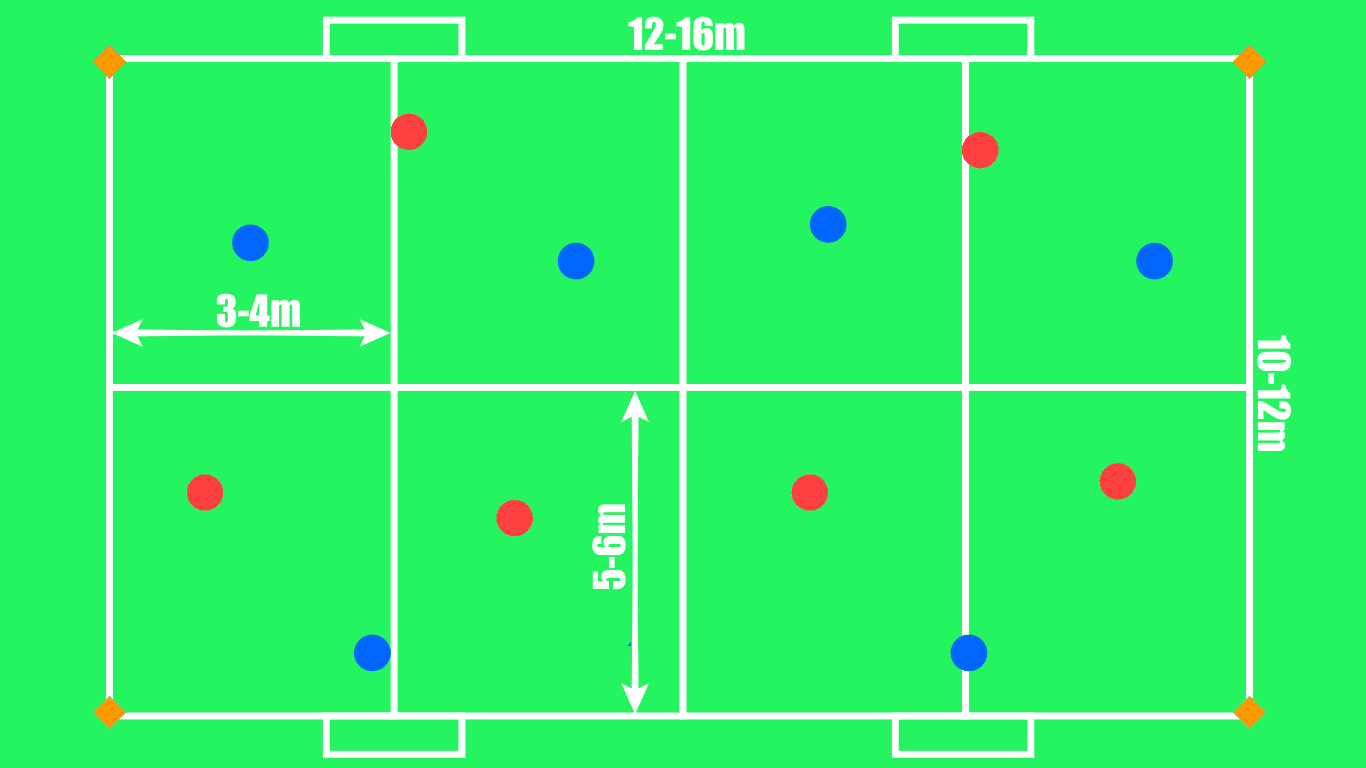
This image illustrates the layout more clearly. Four reds in the lower half of the pitch are each positioned in a rectangle and the same goes for their opponents. Two Reds/Blues are ‘in charge’ of two opposition boxes each and can move freely from one-hand sideline to the vertical half-way line.
The task for both teams is to find the open teammate in the opposing half behind the defensive line and score into one of the two small goals. The defensive target for the team out of possession is to keep connections between each other as strong as possible and to prevent opponents from passing through to the two players positioned in their half by moving together in a correct way and communicating well.
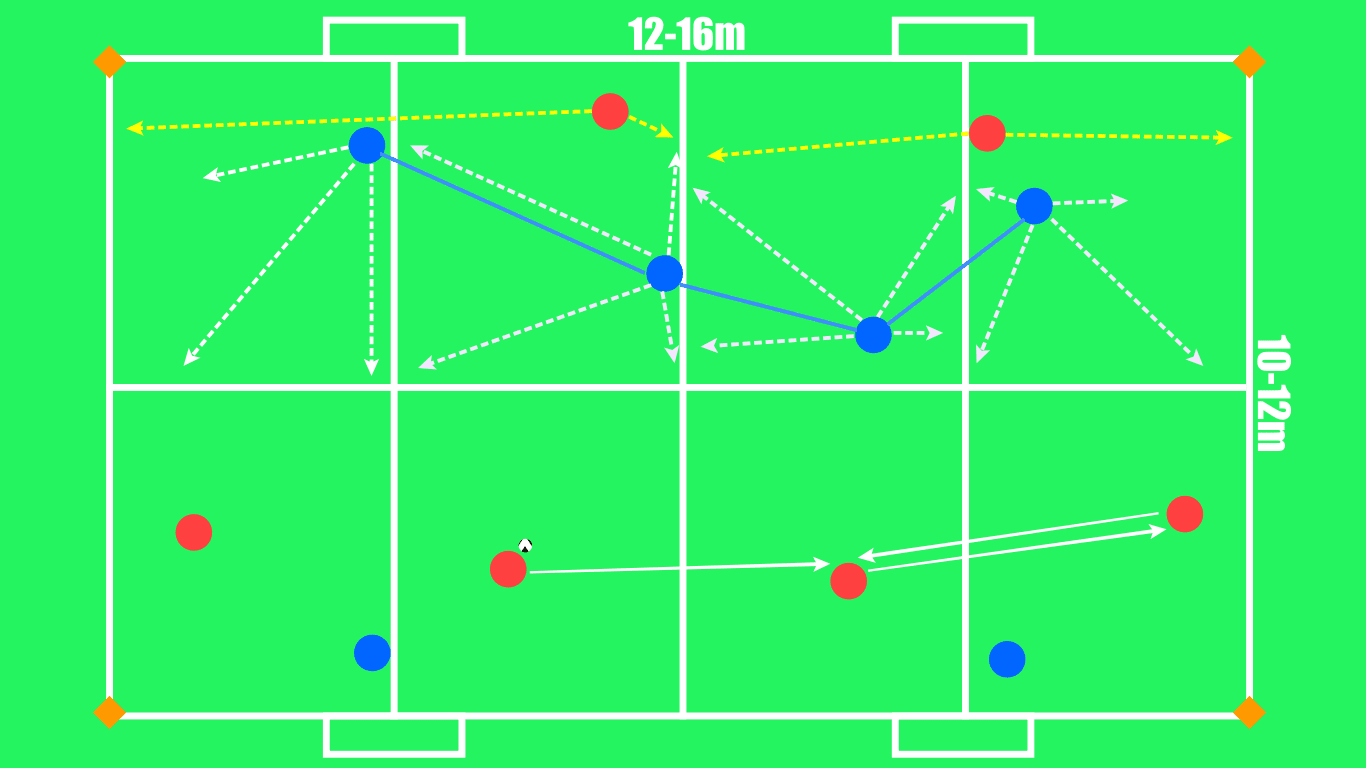
The dashed lines represent player movements pointing out that defenders can only move inside their area whilst each of the two attackers has the freedom to move in two of the four zones. In possession, the team is allowed to pass the ball through the zones in their half of the pitch, but are not allowed to exit their own areas (they don’t have any need to exit them since they are not directly marked!). Their motions are also strictly in their boxes and they need to pass the ball to their teammates when they see it fit.
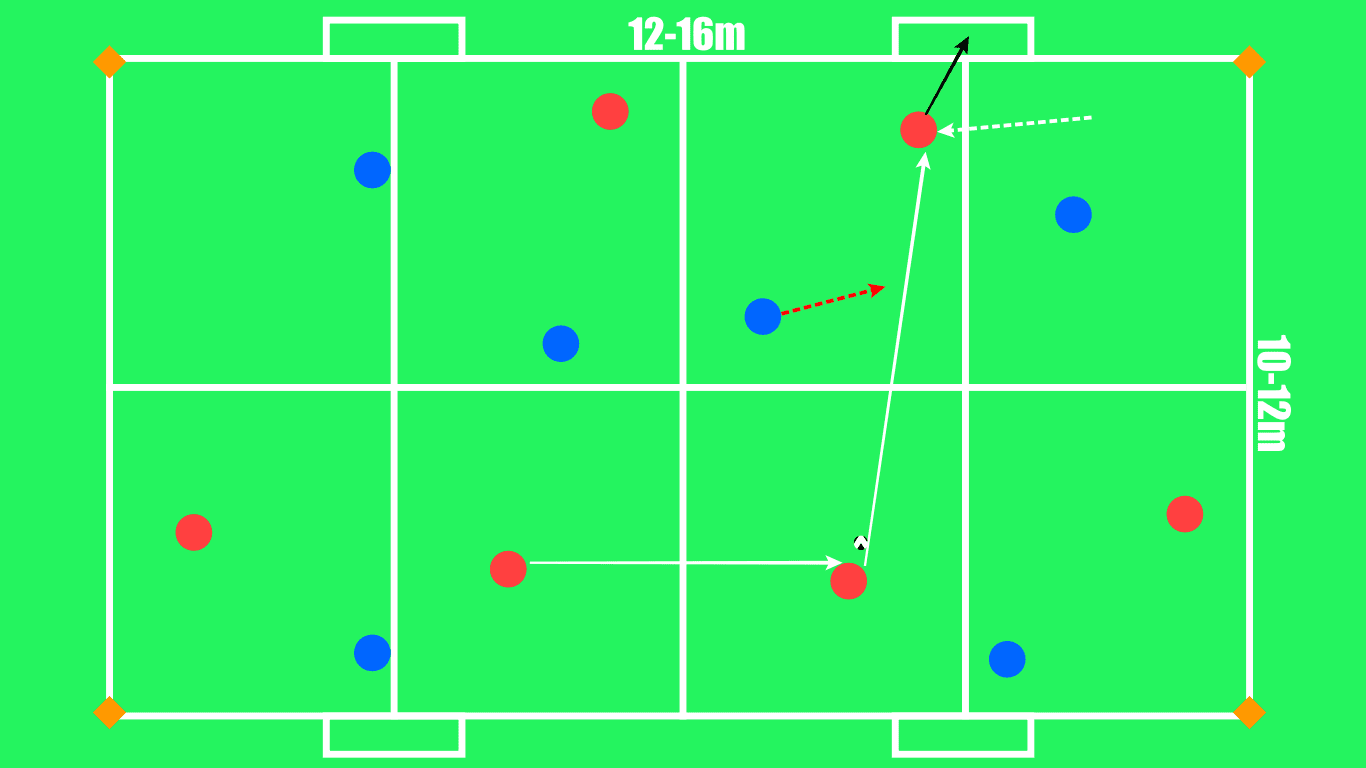
From an offensive perspective, the main idea of the drill is to break down the opposition defensive line with a pass and to exploit the ‘space between the lines.’ Defensively, the aim is to maintain connections inside the defensive structure by communicating and moving together. Defenders need to move compactly and try to close potential passing lanes without coming into contact with the player behind their back. In the scheme above we can see a successful sketch of the game for the in possession team, and obviously unsuccessful for the defenders since they left the passing corridor open for the attacker to get the ball.
When considering your own tactics, you can set the rules of the game accordingly. If you want your team to play a more direct game, and utilise if the opposition is not organised, you should restrict the number of passes the in possession team has between themselves before they decide to penetrate (seven pass-limit is recommended, but you can make it both five or ten). The same goes for the number of touches.
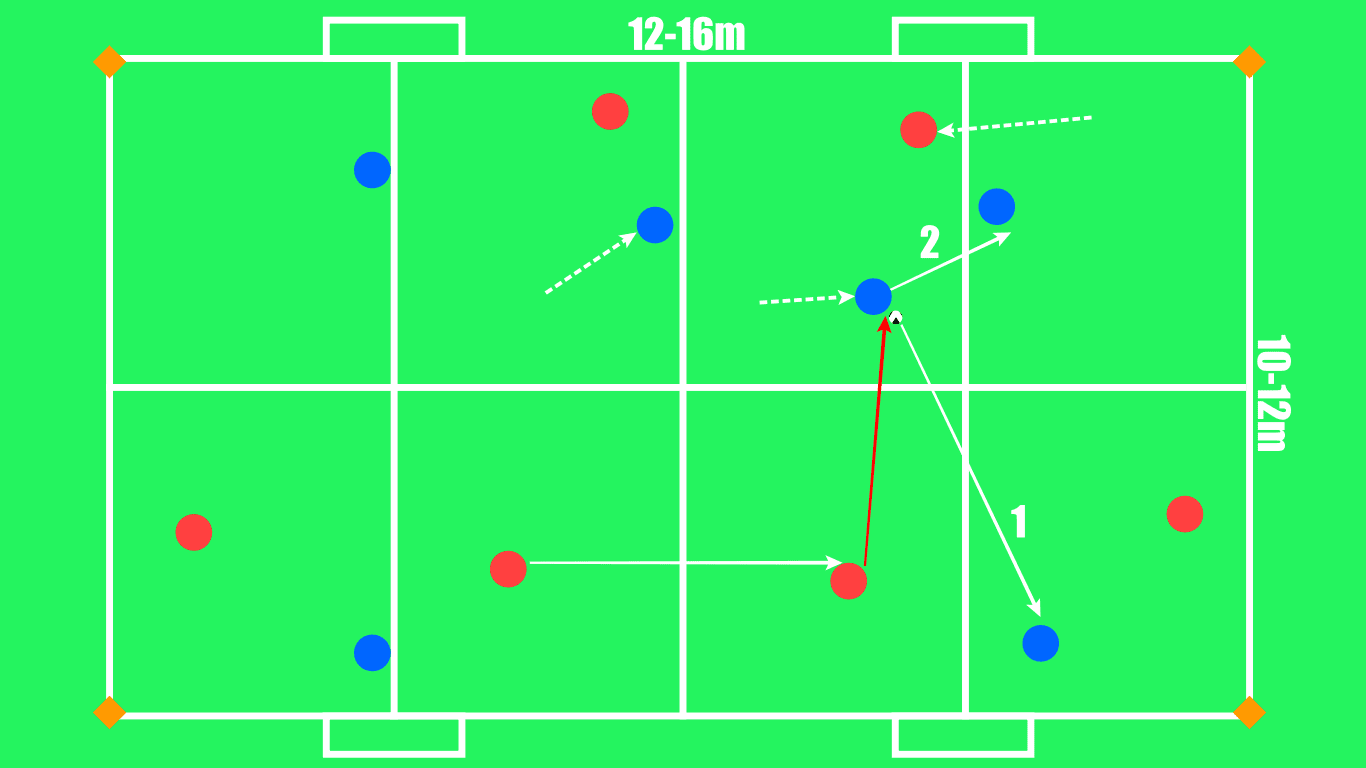
The roles switch once the pass is misplaced and the ball is won by the defender. Tasks and duties can also vary in this scenario depending on your own approach, but the main aim of the drill is for the team that won the ball to always have two options – to circulate the ball through their zones and find the error/gap in the defensive movements, or to play it directly to one of the attackers if the situation arises.
This drill trains a mixture of defensive and offensive compactness. By asking players to move as a unit when defending, this may increase the success for defenders as you try to engage them to communicate better and be well-organised in terms of support and security provision. Circling the ball through the zones in their own half focuses players to stick to their positions in what is basic positional play, whilst offensive progress is triggered with players asking for the ball in-between or behind the defenders’ backs. That’s why this session is a great intro to the main part of the practice where the number of players and the playing pitch will be bigger and more game-related.
Offensive and defensive positional play game
The third game we will show you is the one that is best used in the main part of your session. It is a game-based situational drill with a lot of (simple) duties for players in every segment of the game. The area of action is shaped as a 40x50m rectangle, with two small goals at one end and one regular-sized goal at the opposite one. Inside the field, there is a smaller sized (white) 35×22-24m box, along with four smaller areas set in the middle and on the flanks (like in the picture above).
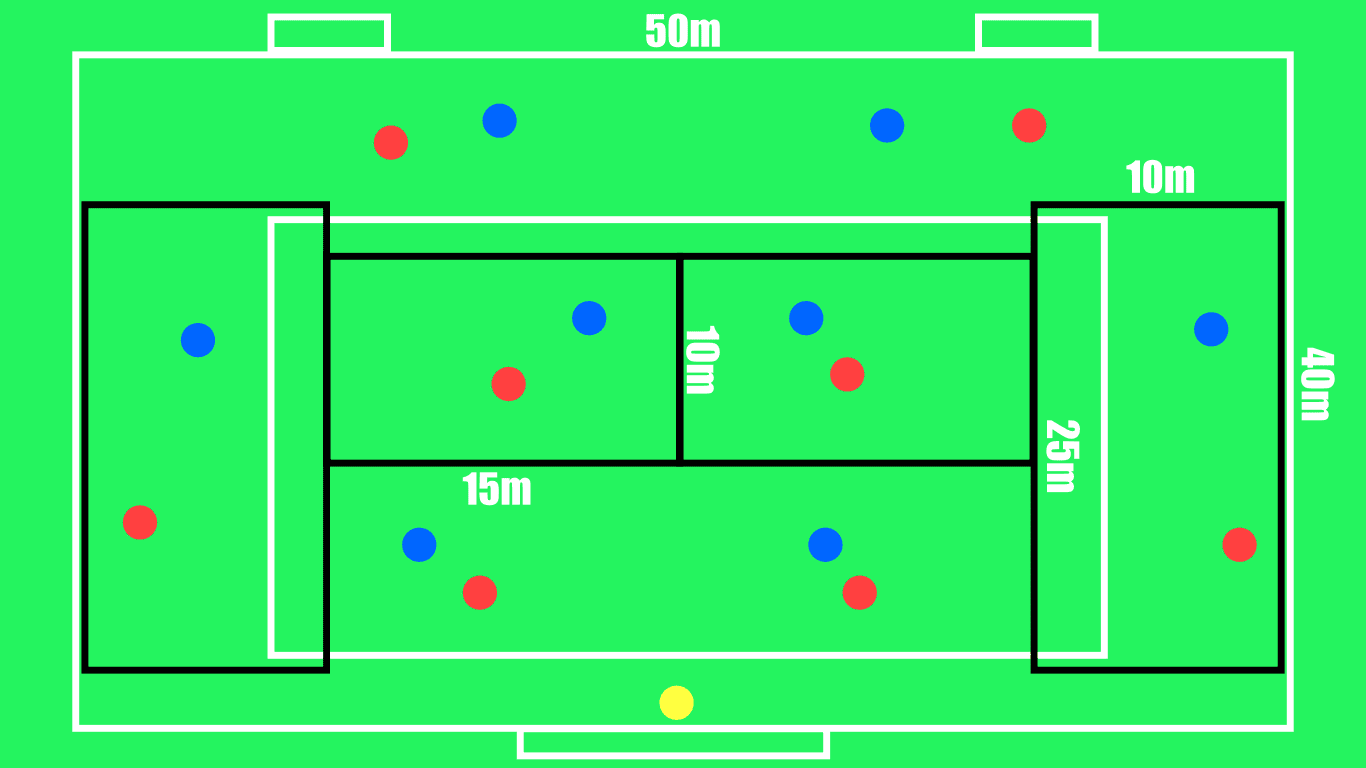
Two black boxes next to the sidelines are 25x10m, whilst the boxes in the centre are both 10x15m. The differences in box shapes (vertical and horizontal ones) and box colours (black and white) will become apparent when explaining the tasks players have and goals of the drill. The number of players included in the game is 17 (8+1v8), and it can be changed to 10v10 game but with slight changes in the pitch layout.
In order to make it as easy to explain as possible, I’ll stick to the 8v8 setup with a goalkeeper playing with one team (reds). The aim of the session is for one team to build up compactness (and after that for the other to do so), both when they have the ball and also once they lose it.
In the first part of the drill, reds will be the in possession team that attacks towards the two small goals with all of the marked areas inside the pitch only referring to their movements. The roles switch after half of the time planned for exercise passes. Blues play without using the boxes up until that moment. That doesn’t mean that they don’t have tasks, but only that their tasks are fewer than the oppositions.
When in possession, some of the reds’ players are ‘locked’ into the black boxes – both of the wide defenders can move only inside the marked flank areas and two midfielders each have one central area for themselves that they are in charge of and can only move within it. The two central defenders can also only move in the space limited by the black zones, while the two attackers are allowed to move freely in the area above these boxes.

Here we can see the permitted movements each player has when the reds are in possession. The white dashed lines roughly represent potential directions of movement for reds (players in the boxes locked in, and players outside locked in the areas outlined with box-lines and pitch-lines) and the red dashed lines represent the potential movements of the defending team from which we can see are free to move in whichever direction/area they want.
The goal for the reds is to manage to score into one of the two small goals by passing through the oppositions whilst keeping their positions and tracking the action inside their areas of operation. For example, if the right centre-back of the red team has the ball, the right full-back will provide him with width staying as wide as possible in his area, the opposite full-back will tuck in and inward himself to provide his side with stability, while one of the midfielders will come in to give the ball carrier a progressive passing option.
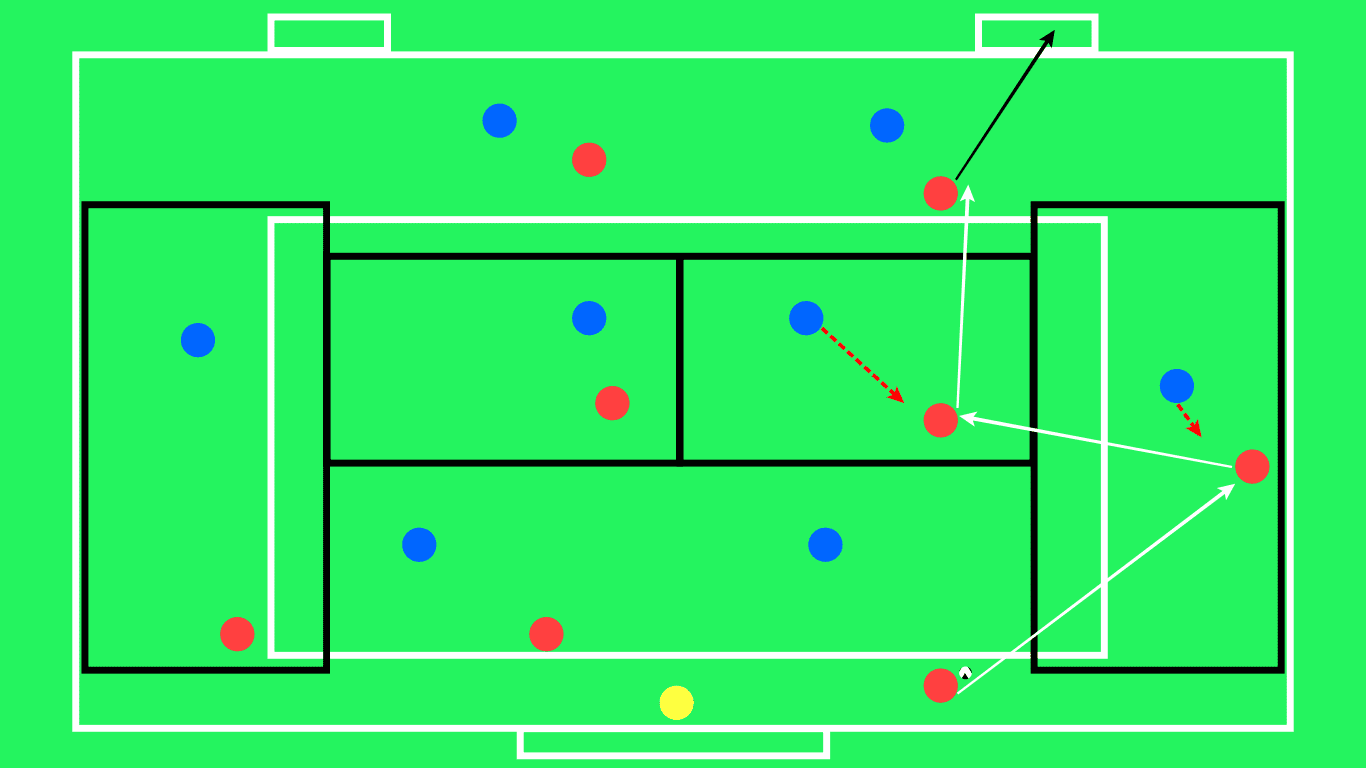
The offensive task for them is to break through the press the blues will set and progress forwards in the opening phase of the build-up which the drill scenario represents. The two goals represent two ‘gambling forwards’ who will enable them to enter the opposition’s half.
Blue players are free to press in whichever way they see fit, trying to stay as compact as possible but with no specific instructions. They can double-team players in different areas, but that means that one of the players will be left open if the press is unsuccessful. Coaches should encourage the in-possession team to think and play as quickly. It isn’t recommended to limit the touches for the reds at first since their movements are limited to inside specific areas and they can face huge pressure from the opponent. This could disrupt the flow of the game, and you should only introduce limited touches once you see the reds are comfortable playing in their positions and are managing to progress. Also, they can use both long and short balls and you can change that as you see it fit.
The possession part of the game for reds when attacking two small goals builds up their offensive compactness and positional awareness, but there’s one more ask for them when they lose the ball. Once the possession is lost, they must work on defensive compactness. After Blues win the ball, they are asked to play less directly (e.g. they can’t score in the first five seconds of the possession). All red players must enter the white rectangle and set themselves up in a compact block.
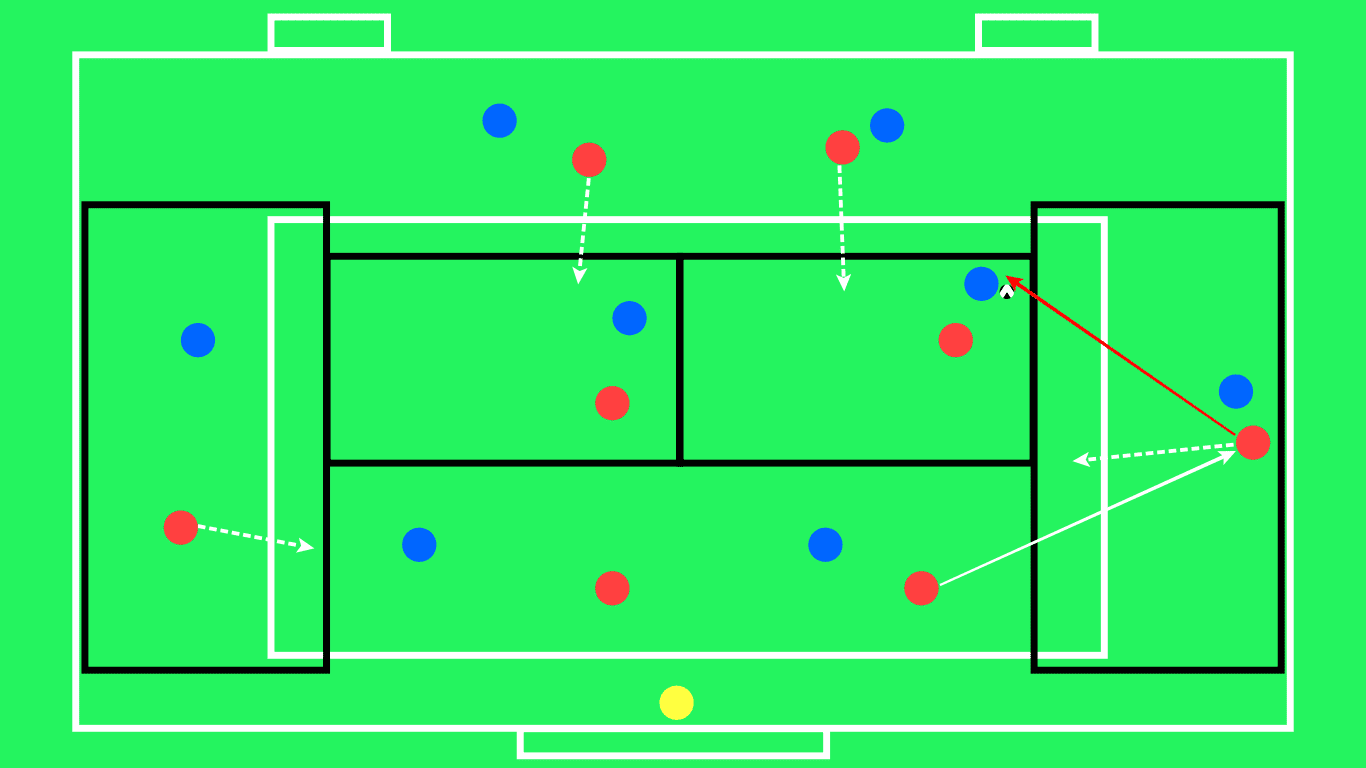
In the painted scheme, you can see the example of movements the red team could use if they lost the ball. After the full-back has misplaced the pass, both full-backs enter the white box along with the two players positioned in the highest area. They try to get compact as quickly as possible and prevent the opposition from breaking through their block.
Of course, those motions depend on a lot of aspects such as the position the ball is lost/won on the pitch, future decisions of attackers, and approaches of coaches – all of which can be included through the rules. For example, if the ball is lost by the two centre-backs, it is clear that there’s no sense for the blues to prolong finishing and the reds don’t have time to set the block so they can score right away. If the ball is lost in higher/wider areas, there’s time for reds to organise so the demand for them to enter the box remains.

The reason behind keeping players inside the boxes is to get players used to organising into a compact block quickly and repeating these movements is the foundation. Certainly, once they tuck in, the flanks break free and it is up to coaches to decide how they will solve these situations. It is recommended to encourage players to come in the block and organise their structure by keeping access to flanks so once they get organised in the middle, they can orient themselves to the flanks and defend in a flowing-block. In order to help reds get the habit of entering the white-marked area, you could ask the blues to play slowly and to deliberately circulate the ball once they won it. Teams switch roles at the halfway point, and the blues undertake all the duties reds had until that moment.
Various modifications of this drill depend on the different tactics coaches like to use, but the main focus of it is on structure and organisation in defence by keeping disciplined positions. It is very applicable in the matches as it is a clear situational drill and helps your team’s players get more comfortable on the ball under pressure and also more comfortable inside the zones in which they operate on a regular basis.
Conclusion
Compactness is one of the key factors in the modern game and it can be trained through a lot of different exercises. This analysis introduced three drills that I find very useful for helping your team develop compactness both offensively and defensively.
As you can see in this analysis, it is clear that compactness has a great influence on both the attacking and defending phase of the game. This concept enables forward passing options in-possession and prepares a team to be ready to react if the ball is lost. Additionally, it helps a team establish control over the area(s) of the pitch and lure opponents into defensive traps. By improving this aspect of your tactics, you can make a first step towards controlling many actions throughout a match, and it can help you dominate different phases of the game by utilizing the principles of compactness.

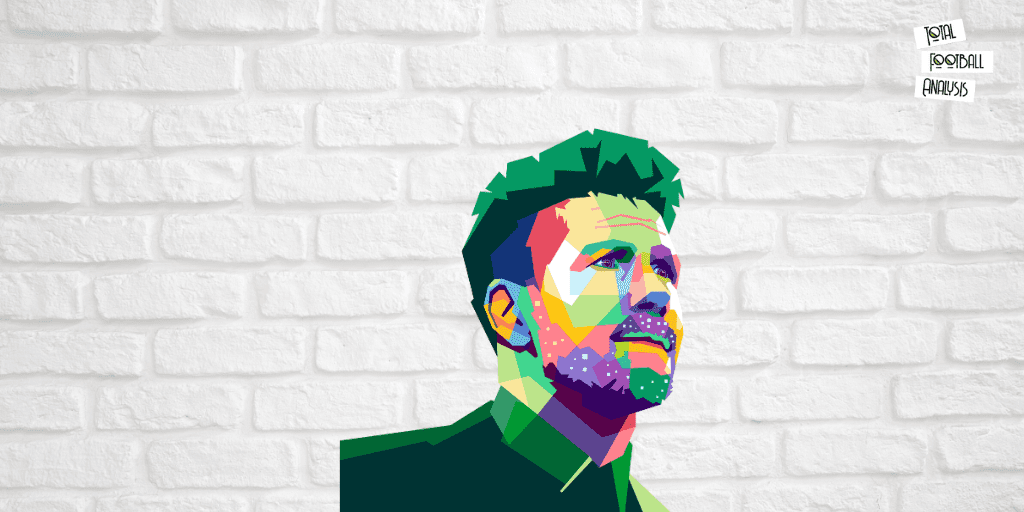



Comments